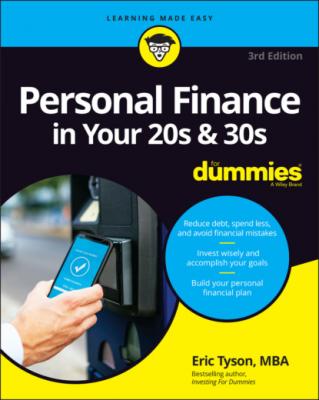Personal Finance in Your 20s & 30s For Dummies. Eric Tyson
Чтение книги онлайн.
Читать онлайн книгу Personal Finance in Your 20s & 30s For Dummies - Eric Tyson страница 17
 resources, you need to prioritize your goals. Before funding your retirement accounts and racking up those tax breaks, you should consider your other goals, such as starting or buying a business or buying a home.
resources, you need to prioritize your goals. Before funding your retirement accounts and racking up those tax breaks, you should consider your other goals, such as starting or buying a business or buying a home.
If you withdraw funds from traditional retirement accounts before age 59½, you not only have to pay income taxes on the withdrawals but also usually have to pay early withdrawal penalties — 10 percent of the withdrawn amount in federal tax, plus whatever your state charges. So if you’re accumulating money for a down payment on a home or to start or buy a business, you probably should save that money outside of a retirement account so you get penalty-free access to the funds.
Saving When You’re Strapped
You know that putting aside some money on a regular basis is important, but you may wonder how realistic it is, especially when you’re burdened with a never-ending list of bills or are starting out on your own. And, those six-figure-per-year jobs haven’t yet come your way! So what do you do? The first and most important thing is to work at paying down high-cost debt (see Chapter 3).
Chapter 3
Using Loans and Paying Down Debts
IN THIS CHAPTER
Borrowing money and taking on debt is like using a chainsaw. With proper training and safety precautions, a chainsaw can be a useful tool. In the hands of an insufficiently trained user or when used in the wrong situations, this otherwise helpful tool can do serious damage. The same can be said for borrowing money. Used sensibly, loans can help you accomplish important goals — such as furthering your education, buying real estate, or expanding your business — and boost your net worth over time. Unfortunately, taking on debt can also cause problems: living beyond your means, borrowing against your future earnings, and lowering your longer-term net worth. Too much debt and the wrong kind of high-cost debt can also cause personal stress.
In this chapter, I help you understand the best uses for loans and what debts to avoid. I also explain how to deal with and vanquish student-loan debt and how to conquer the all-too-common problem of consumer debt on credit cards, auto loans, and so on.
Eyeing the Causes of Generational Debt
For a number of years now, it has been argued that young adults are under pressures that lead them to go deeper into debt than prior generations. The reasons cited for this generational debt have typically included the following:
High costs of college: Annual increases in the costs of a college education have far outstripped the increases in general prices of other products and services. The price of some private colleges now is over $80,000 per year!
Stagnating incomes and job prospects: Most industries and companies compete in an increasingly global economy. And, the Internet has undermined and disrupted numerous retailers and other industries, causing incomes in those businesses to stagnate.
High housing costs: The 1990s and most of the 2000s saw rising housing prices, which priced many entry-level buyers out of their local markets.
College campus credit-card promotions: The availability and promotion of credit cards is a big problem. Credit cards are tempting to use during college when your income is minimal or nonexistent. Due to the high number of college students getting into unmanageable credit-card debt, the CARD Act of 2009 restricts card issuers from marketing within 1,000 feet of college campuses. But beware, they set up right across the street and bombard young adults at the age of 21 with all sorts of offers and solicitations. This practice and credit cards offering rewards are getting more young adults hooked on credit cards.
Economic disruptions: Plenty of young people had their jobs and economic lives take a hit during and in the aftermath of the 2008 financial crisis and the 2020 COVID-19 pandemic.
More temptations to spend money: Never before have so many temptations existed for spending money through so many outlets. In addition to the ubiquity of places to shop both nearby and online, people are bombarded with ads everywhere.
Most of these reasons for incurring generational debt are valid. In truth, however, this gloomy list isn’t really fair and balanced. Here are some counter-arguments to the previous list:
Less costly higher-education options are increasing in number. Yes, there are plenty of high-priced four-year colleges, especially private ones. But they don’t have a monopoly on the best higher-education options!
Unemployment hit a 50-year low just before the 2020 COVID-19 pandemic hit. And incomes were rising briskly, especially for those near or below the median income levels. (While the Internet and big tech companies have their downsides, it’s easier now to research and find better values online, which enables smart consumers to get more bang for their bucks.)
Many metro areas have affordable housing, and more workers can work remotely. Increasing numbers of employers are actively trying to grow their employment away from high-cost cities such as New York, San Francisco, and the like.
College students don’t need to have a credit card, which is the cause of students potentially running up debts they will be unable to quickly pay off. Debit cards, with a VISA or MasterCard logo, enable students to pay for items and then have the funds immediately deducted from their checking account, thus preventing them from spending money that they don’t have.
Opportunities happen during periods of economic